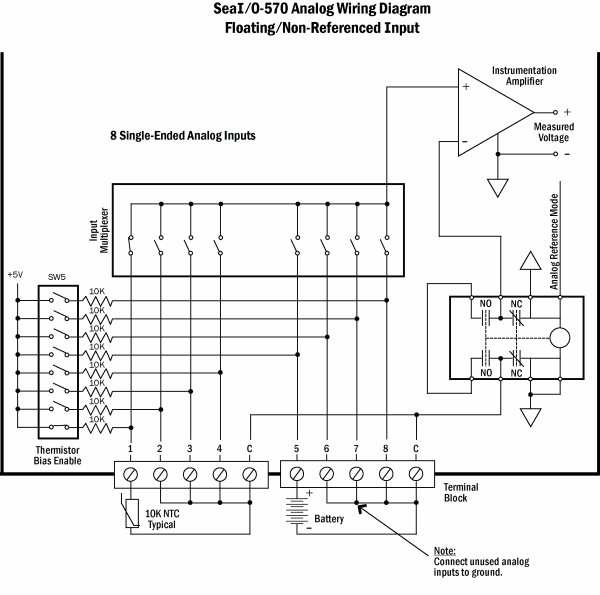Interfacing Analog Signals to SeaI/O-570 Modules
Overview
The SeaI/O-570 A/D inputs can measure signals from a variety of sensors including accelerometers, flow meters, photocells, strain gauges and thermistors. This makes the SeaI/O-570 ideal for applications such as measuring force, pressure, temperature or weight. The analog inputs on the SeaI/O-570 support floating, non-referenced signals or ground referenced signals, and can operate in unipolar or bipolar modes. The analog input modes and additional settings can be configured and verified via Sealevel SeaMAX software, which includes the SeaMAX API, MaxSSD utility, and Modbus support. Additionally, a dipswitch on the PCB enables a bias voltage of +5 through a 10K ohm resistor for thermistor input mode.
Floating Signal Source Wiring Guide
A floating, non-referenced signal source is a signal that is not connected in any fashion to the building ground system but rather has an isolated ground reference point. Examples of floating signal sources are outputs of transformers, thermistors, and battery-powered devices. To measure these devices, the ground reference point must be set to the analog ground reference of the SeaI/O-570 as shown in the below schematic. Without this connection, the signals will float and an accurate measurement is not possible. The SeaI/O-570 is configured to measure floating, non-referenced signals by default.
Ground-Referenced Signal Sources Wiring Guide
A ground-referenced signal is a signal that is connected in some fashion to the building system ground and therefore is already connected to a common ground point with respect to the SeaI/O-570. Examples would be non-isolated outputs of instruments and devices that are connected to the same building power system as the SeaI/O-570. The difference in ground potential between two devices connected to the same building power system is typically 1mV to 100mV and can be much higher with improper power system grounding. This ground potential difference can show up as a measurement error without using the proper measurement connections. The connection scheme below is designed to eliminate this ground potential difference from the measurement. This setting can be configured and verified via Sealevel SeaMAX software.
Thermistor Inputs
On the SeaI/O-570 PCB, Switch 5 (SW5) allows each of the eight A/D channels to be individually configured for a thermistor by moving the corresponding channel selector (1-8) to the On position. This will apply a bias voltage of +5V through a 10K Ohm resistor. Connect the thermistor between the input and ground reference on the SeaI/O-570s terminal block connector. This will create a voltage divider and as the resistance of the thermistor changes so will the voltage read by the application. Please reference the data sheet of the chosen thermistor to calculate the measured temperature.


